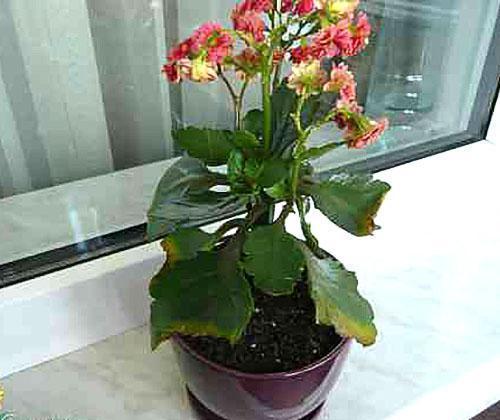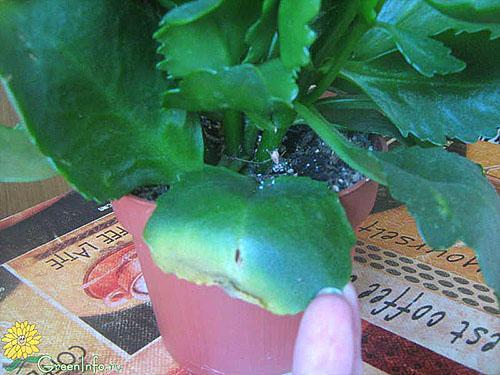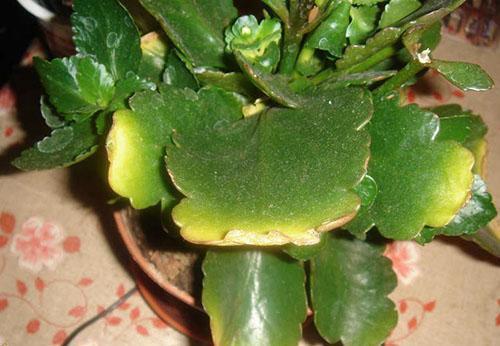Why Kalanchoe leaves turn yellow on the windowsill
 Kalanchoe is a favorite houseplant of flower growers around the world. After all, a flower can delight its owners with beautiful decorative flowering almost all year round. Another advantage of this culture can be attributed to the fact that it reproduces quite easily and does not require special manipulations when planting. However, despite all the unpretentiousness, it will not be so easy to get an attractive copy without proper care. In addition, improper care can lead to more serious problems.
Kalanchoe is a favorite houseplant of flower growers around the world. After all, a flower can delight its owners with beautiful decorative flowering almost all year round. Another advantage of this culture can be attributed to the fact that it reproduces quite easily and does not require special manipulations when planting. However, despite all the unpretentiousness, it will not be so easy to get an attractive copy without proper care. In addition, improper care can lead to more serious problems.
The most pressing question, which quite often appears in various flower growers' forums, is why do Kalanchoe leaves turn yellow? There may be several reasons for this phenomenon. Let's consider in more detail the main options.
Causes of yellowing leaves

- non-compliance with landing technology;
- improperly selected soil;
- wrong choice of location;
- non-observance of the proper temperature regime;
- wrong organization glaze;
- insufficient or excess amount of minerals and trace elements.
 Of course, you should definitely consider the possibility of the appearance of various pests, as well as the fact that the leaves can turn yellow and fall off for natural reasons, that is, when their life cycle comes to an end. If the root of the problem is in improper care, then in order to avoid such troubles, you should figure out how to correctly perform each of the indicated points.
Of course, you should definitely consider the possibility of the appearance of various pests, as well as the fact that the leaves can turn yellow and fall off for natural reasons, that is, when their life cycle comes to an end. If the root of the problem is in improper care, then in order to avoid such troubles, you should figure out how to correctly perform each of the indicated points.
Planting and transplanting Kalanchoe
 A new specimen of a flower culture can appear in our homes through a purchase in specialized stores or in the case of a gift of a small shoot. In principle, it does not matter at all which way the Kalanchoe was acquired, perhaps it’s just time to transplant a long-growing flower, it is only important to plant it correctly. A favorable period for planting, of course, is spring. First of all, you need to prepare the potting mix and container for placing the plant.
A new specimen of a flower culture can appear in our homes through a purchase in specialized stores or in the case of a gift of a small shoot. In principle, it does not matter at all which way the Kalanchoe was acquired, perhaps it’s just time to transplant a long-growing flower, it is only important to plant it correctly. A favorable period for planting, of course, is spring. First of all, you need to prepare the potting mix and container for placing the plant.
 The pot should not be too spacious, or you can place several layers at once in one container. As for the filling, the earth for the Kalanchoe should be loose, you can prepare the following composition: mix in equal parts humus, sand, leaf and sod soil. You can also find ready-made mixtures designed specifically for succulents. The plant should be handled carefully, as it has rather fragile leaves and stems. A drainage layer is laid at the bottom of the pot, and soil is poured on top to about half the volume. Next, a scion is placed and the remaining earth is filled up. The pot should be shaken a little to fill the voids and spill generously with room temperature water. If the soil has settled heavily, then it is necessary to make another bedding.
The pot should not be too spacious, or you can place several layers at once in one container. As for the filling, the earth for the Kalanchoe should be loose, you can prepare the following composition: mix in equal parts humus, sand, leaf and sod soil. You can also find ready-made mixtures designed specifically for succulents. The plant should be handled carefully, as it has rather fragile leaves and stems. A drainage layer is laid at the bottom of the pot, and soil is poured on top to about half the volume. Next, a scion is placed and the remaining earth is filled up. The pot should be shaken a little to fill the voids and spill generously with room temperature water. If the soil has settled heavily, then it is necessary to make another bedding.
When buying a flower in a store, be sure to transplant it in the near future. Indeed, in the display cases, the plants are in pots filled with transport earth, in which there are no nutrients, but only flowering stimulants. If you keep the plant in such soil for a long time, it can lead to its death.
Home care
 The transplanted flower should be placed in a bright and warm place, because the Kalanchoe belongs to light-loving cultures. The ideal location is the southwest or southeast window. On the south side or in direct sunlight, the tips of the leaves may begin to turn yellow. As for the temperature, it should not be higher than 30 and not lower than 20 degrees from spring to autumn, and in winter it is advisable to give the flower a rest, reducing the temperature to an average of 15 degrees.
The transplanted flower should be placed in a bright and warm place, because the Kalanchoe belongs to light-loving cultures. The ideal location is the southwest or southeast window. On the south side or in direct sunlight, the tips of the leaves may begin to turn yellow. As for the temperature, it should not be higher than 30 and not lower than 20 degrees from spring to autumn, and in winter it is advisable to give the flower a rest, reducing the temperature to an average of 15 degrees.
Kalanchoe is a plant that prefers 10-hour daylight hours. This allows for abundant flowering and full development of flower culture. That is why the day should be artificially shortened in summer, and in winter, on the contrary, slightly prolonged, highlighting the plant.
The next moment is watering the Kalanchoe. Yellowing of leaves can occur both with insufficient amount of water, and with its excess. You can determine the specific cause during an external examination. If the leaves are darkened and curled, then the amount of moisture should be increased, but if the leaves are pale yellow and soft, then the amount of water should be reduced. Experts recommend watering the plant more abundantly in summer and moderately in winter. For this purpose, it is worth using only warm and settled water. If it is hot in the room where the flower is located, then you can organize spraying on the leaf. However, such a procedure should be carried out quite rarely, because with increased moisture, the flower can begin to rot.
 The cause of Kalanchoe leaf disease is often excessive watering, in which case powdery mildew or low temperatures may develop, at which gray mold often appears. Also, the appearance of the flower can be spoiled with a lack of minerals or an excess of them. Experts recommend feeding the plant 2 times a month during the growth period (that is, from spring to autumn). For this purpose, you can use a ready-made mixture, for example, for cacti.
The cause of Kalanchoe leaf disease is often excessive watering, in which case powdery mildew or low temperatures may develop, at which gray mold often appears. Also, the appearance of the flower can be spoiled with a lack of minerals or an excess of them. Experts recommend feeding the plant 2 times a month during the growth period (that is, from spring to autumn). For this purpose, you can use a ready-made mixture, for example, for cacti.
Florists advise you to take a closer look at the plant, sometimes by the state of the leaves you can understand which elements are missing. In particular:
- the browning of the edges of the leaves causes a lack of boron;
- slow plant development and small leaves indicate a lack of nitrogen;
- spots on the leaves and the death of shoots - this is the reason for the lack of molybdenum;
- yellowing, wrinkling or dying off of the lower foliage indicates an excess of phosphorus.
Summing up, we can say that the appearance of a plant depends on how its content will be organized. In general, home care for the Kalanchoe flower, the photo of which can be seen below, is not particularly difficult and is quite within the power of even beginner growers.





